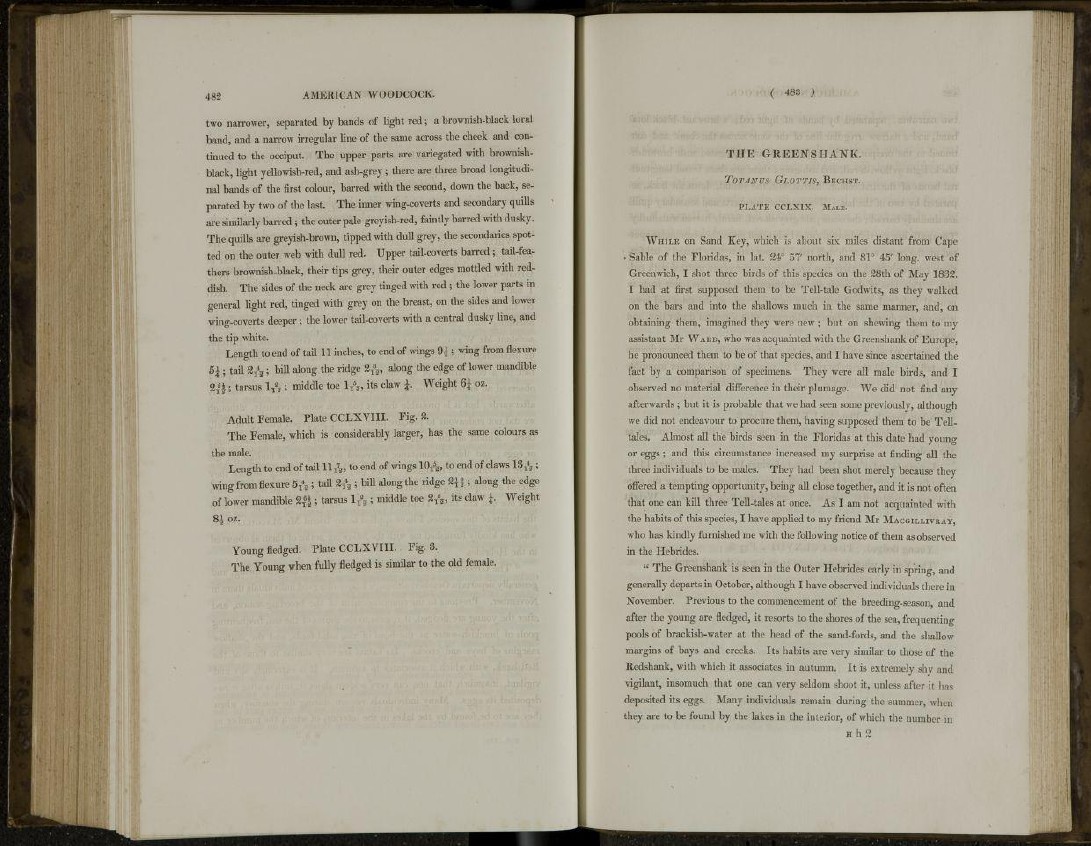
482 AMERICAN WOODCOCK.
two narrower, separated by bands of light red; a brownish-black loral
band, and a narrow irregular line of the same across the cheek and continued
to the occiput. The upper parts are variegated with brownishblack,
light yellowish-red, and ash-grey ; there are three broad longitudinal
bands of the first colour, barred with the second, down the back, separated
by two of the last. The inner wing-coverts and secondary quills
are similarly barred ; the outer pale greyish-red, faintly barred with dusky.
The quills are greyish-brown, tipped with dull grey, the secondaries spotted
on the outer web with dull red. Upper tail-coverts barred ; tail-feathers
brownish-black, their tips grey, their outer edges mottled with reddish.
The sides of the neck are grey tinged with red ; the lower parts in
general light red, tinged with grey on the breast, on the sides and lower
wing-coverts deeper; the lower tail-coverts with a central dusky line, and
the tip white.
Length to end of tail 11 inches, to end of wings 9 (} ; wing from flexure
5£ ; tail 2 T
4
g ; bill along the ridge 2T
8
2 , along the edge of lower mandible
2T
5
2 ; tarsus %gg ; middle toe l T
5 j , its claw Weight 6£ oz.
Adult Female. Plate CCLXVIII. Fig. 2.
The Female, which is considerably larger, has the same colours as
the male.
Length to end of tail 11 T
7
2 , to end of wings 10T
5^, to end of claws 1 3 ^ ;
wing from flexure 5X
4
2 ; tail 2 ^ ; bill along the ridge °4§ ; along the edge
of lower mandible 2 | | ; tarsus 1 T
2
3 ; middle toe 2T
5
2 , its claw Weight
8£ oz.
Young fledged. Plate CCLXVIII. Fig. 3.
The Young when fully fledged is similar to the old female.
( 483 )
THE GREENSIIANK.
TOTANUS GLOTTIS, BECHST.
PLATE CCLXIX. MALE.
WHILE on Sand Key, which is about, six miles distant from Cape
• Sable of the Floridas, in lat. 24° 57 north, and 81° 45' long, west of
Greenwich, I shot three birds of this species on the 28th of May 1832.
I had at first supposed them to be Tell-tale Godwits, as they walked
on the bars and into the shallows much in the same manner, and, on
obtaining them, imagined they were new; but on shewing them to my
assistant Mr WARD, who was acquainted with the Greenshank of Europe,
he pronounced them to be of that species, and I have since ascertained the
fact by a comparison of specimens. They were all male birds, and I
observed no material difference in their plumage. We did not find any
afterwards ; but it is probable that we had seen some previously, although
we did not endeavour to procure them, having supposed them to be Telltales.
Almost all the birds seen in the Floridas at this date had young
or eggs ; and this circumstance increased my surprise at finding all the
three individuals to be males. They had been shot merely because they
offered a tempting opportunity, being all close together, and it is not often
that one can kill three Tell-tales at once. As I am not acquainted with
the habits of this species, I have applied to my friend Mr MACGILLIVRAY,
who has kindly furnished me with the following notice of them as observed
in the Hebrides.
" The Greenshank is seen in the Outer Hebrides early in spring, and
generally departs in October, although I have observed individuals there in
November. Previous to the commencement of the breeding-season, and
after the young are fledged, it resorts to the shores of the sea, frequenting
pools of brackish-water at the head of the sand-fords, and the shallow
margins of bays and creeks. Its habits are very similar to those of the
Redshank, with which it associates in autumn. It is extremely shy and
vigilant, insomuch that one can very seldom shoot it, unless after it has
deposited its eggs. Many individuals remain during the summer, when
they are to be found by the lakes in the interior, of which the number in
H h 2